Abstract
The unique nonrespiratory functions of the lungs have become more apparent in recent years. The isolated perfused lung model offers many advantages over other methods for the study of pulmonary metabolism, xenobiotic disposition and the influence of interactions among agents of different physical forms. Detailed descriptions of the experimental preparation are elements in evaluating and comparing data from various sources but these are frequently neglected. A discussion and critique of the following elements are provided in this review in order to elucidate the typical problems one might encounter in evaluating data: perfusate type, perfusion method, construction materials, ventilation method, temperature control, surgical procedure, microbiological contamination and evaluation criteria of the preparation. Examples are given where the IPL method has been applied and suggestions are made for future research efforts.
Full text
PDF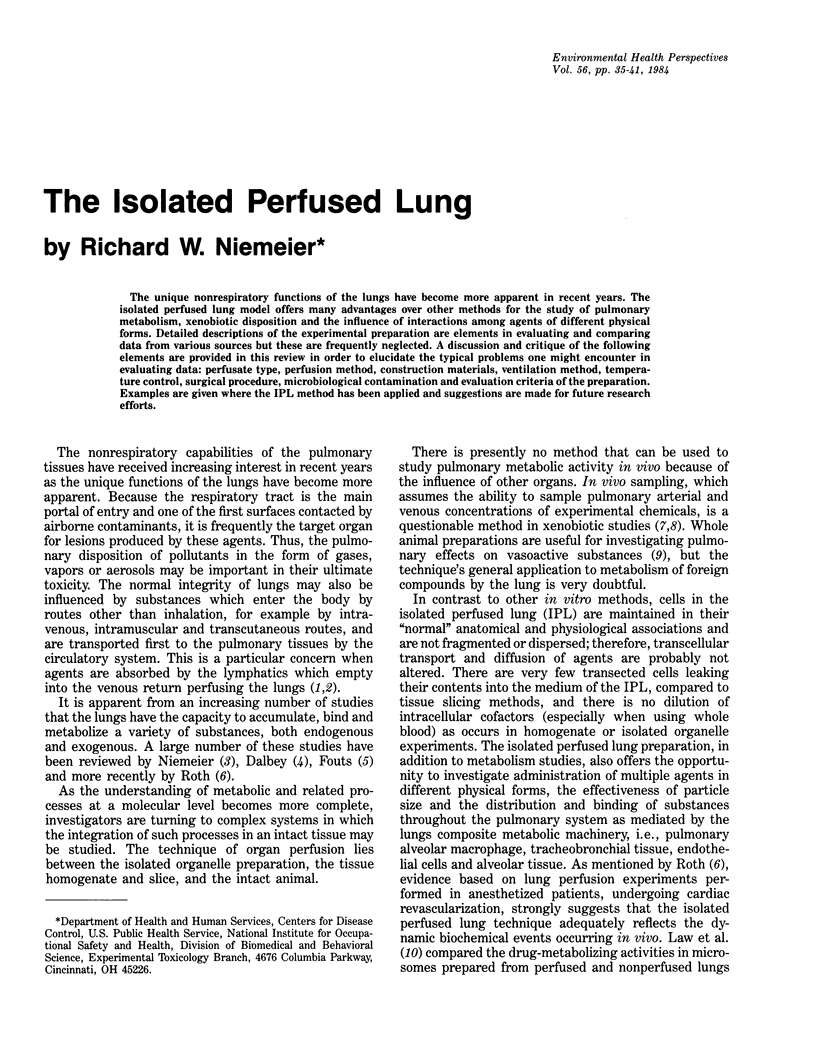
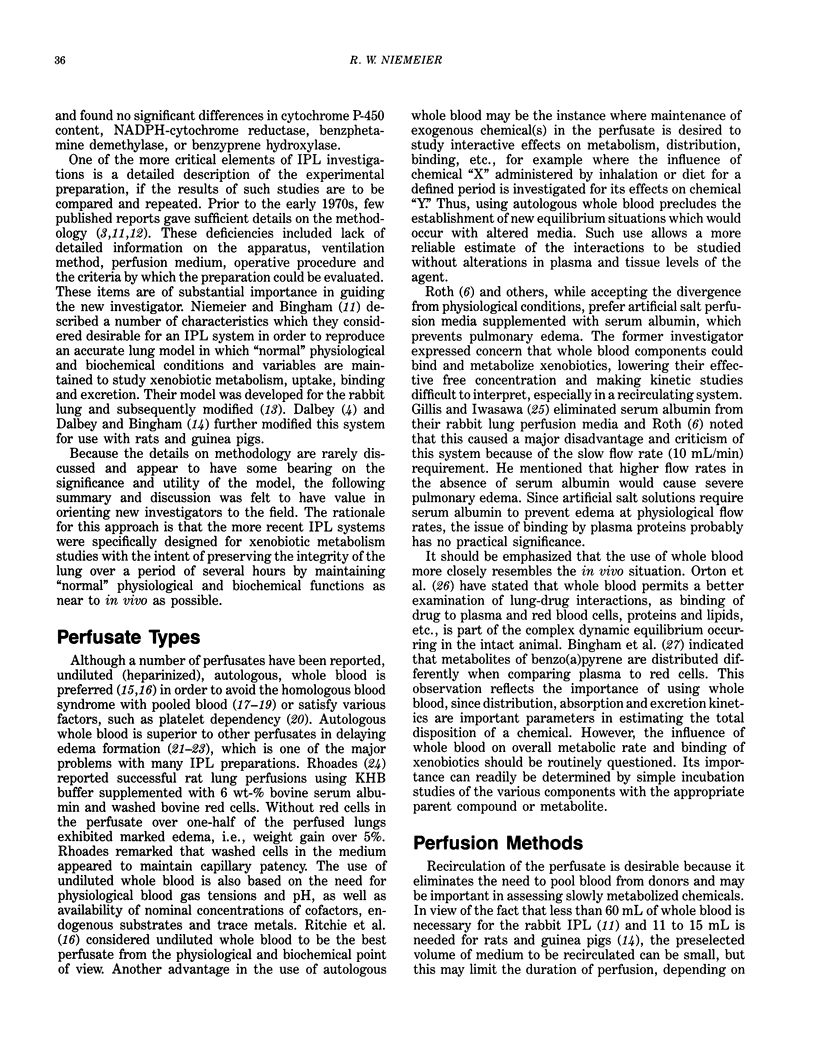
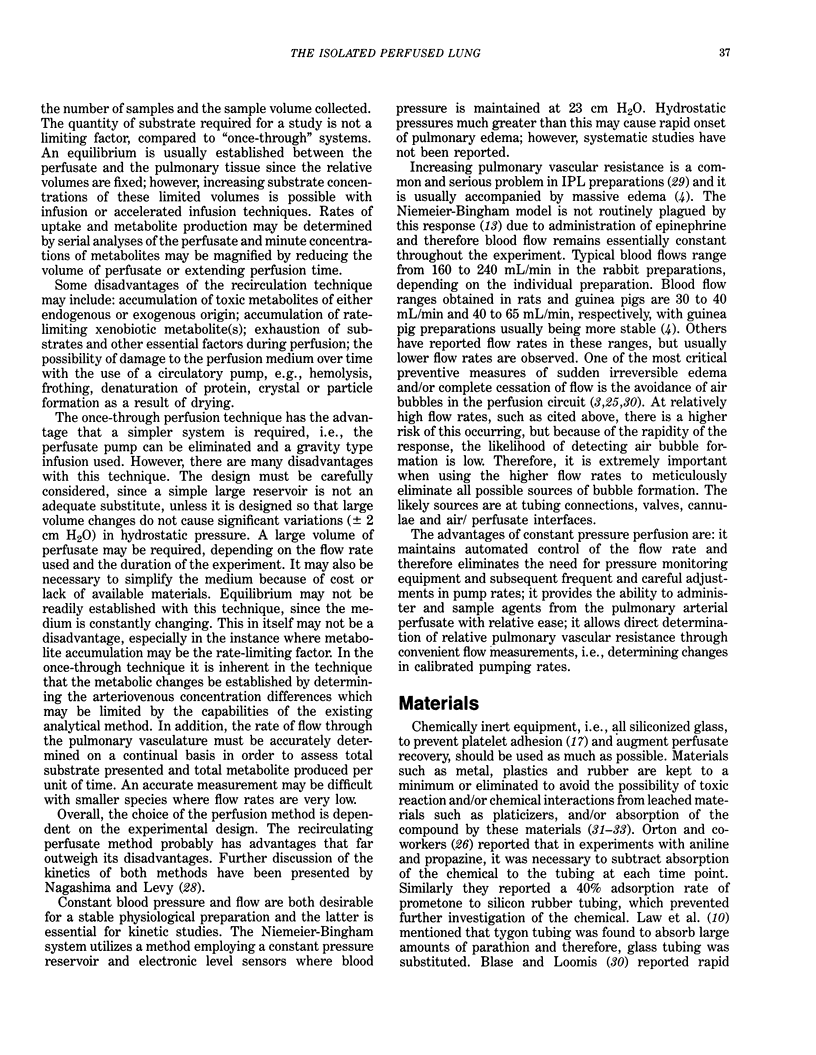
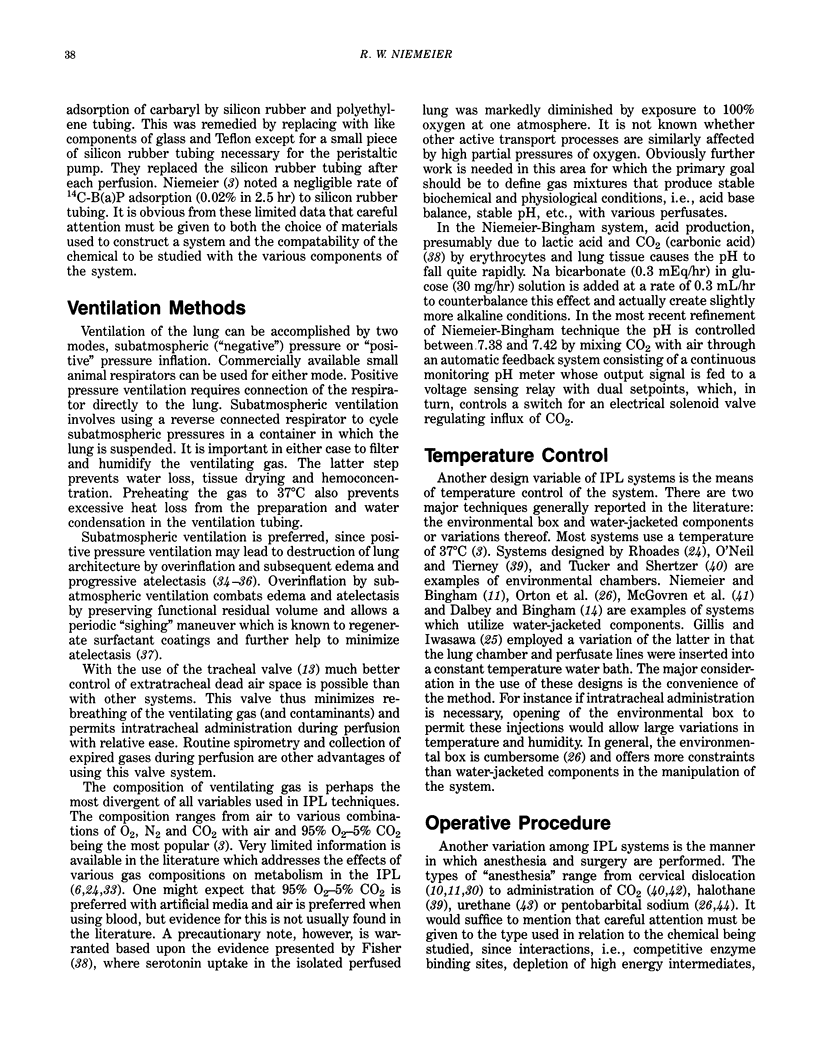

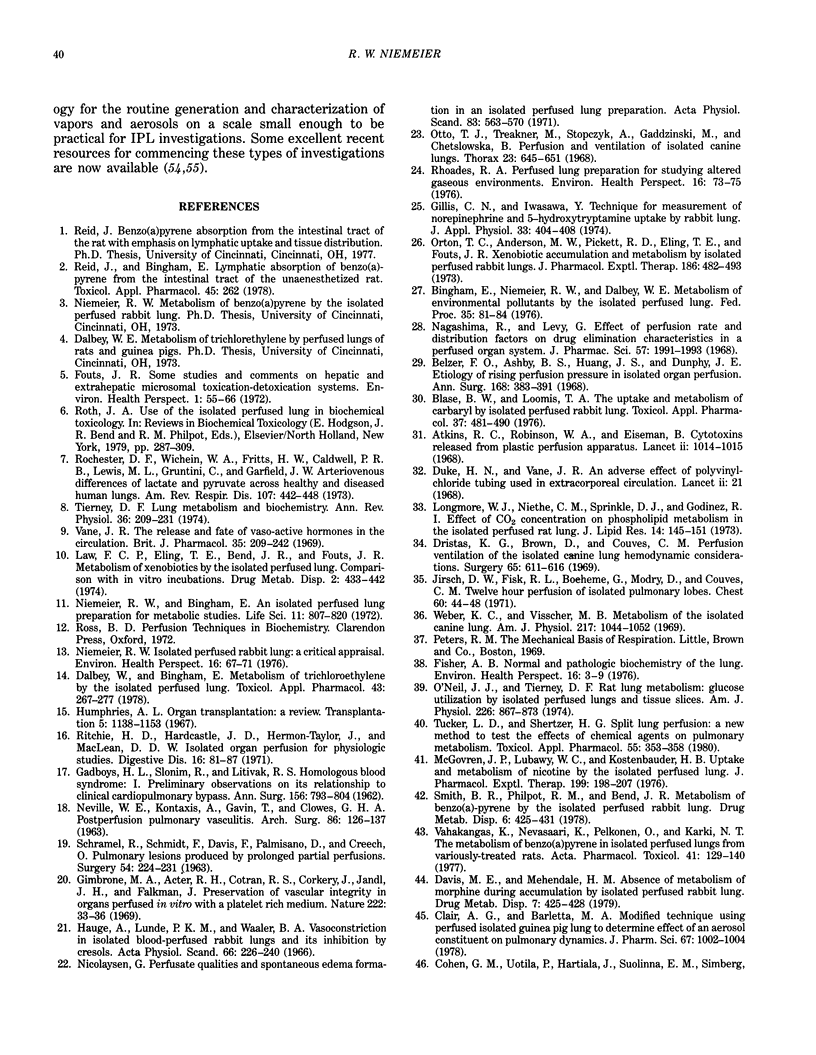

Selected References
These references are in PubMed. This may not be the complete list of references from this article.
- Atkins R. C., Robinson W. A., Eiseman B. Cytotoxins released from plastic perfusion apparatus. Lancet. 1968 Nov 9;2(7576):1014–1015. doi: 10.1016/s0140-6736(68)91301-9. [DOI] [PubMed] [Google Scholar]
- Belzer F. O., Ashby B. S., Huang J. S., Dunphy J. E. Etiology of rising perfusion pressure in isolated organ perfusion. Ann Surg. 1968 Sep;168(3):382–391. doi: 10.1097/00000658-196809000-00008. [DOI] [PMC free article] [PubMed] [Google Scholar]
- Bingham E., Niemeier R., Dalbey W. Metabolism of environmental pollutants by the isolated perfused lung. Fed Proc. 1976 Jan;35(1):81–84. [PubMed] [Google Scholar]
- Blase B. W., Loomis T. A. The uptake and metabolism of carbaryl by isolated perfused rabbit lung. Toxicol Appl Pharmacol. 1976 Sep;37(3):481–490. doi: 10.1016/0041-008x(76)90210-6. [DOI] [PubMed] [Google Scholar]
- Clair A. G., Barletta M. A. Modified technique using perfused isolated guinea pig lung to determine effect of an aerosol constituent on pulmonary dynamics. J Pharm Sci. 1978 Jul;67(7):1002–1004. doi: 10.1002/jps.2600670736. [DOI] [PubMed] [Google Scholar]
- Cohen G. M., Uotila P., Hartiala J., Suolinna E. M., Simberg N., Pelkonen O. Metabolism and covalent binding of [3H]benzo(a)pyrene by isolated perfused lungs and short-term tracheal organ culture of cigarette smoke-exposed rats. Cancer Res. 1977 Jul;37(7 Pt 1):2147–2155. [PubMed] [Google Scholar]
- Dalbey W., Bingham E. Metabolism of trichloroethylene by the isolated perfused lung. Toxicol Appl Pharmacol. 1978 Feb;43(2):267–277. doi: 10.1016/0041-008x(78)90006-6. [DOI] [PubMed] [Google Scholar]
- Davis M. E., Mehendale H. M. Absence of metabolism of morphine during accumulation by isolated perfused rabbit lung. Drug Metab Dispos. 1979 Nov-Dec;7(6):425–428. [PubMed] [Google Scholar]
- Dritsas K. G., Brown D., Couves C. M. Perfusion-ventilation of the isolated canine lung: hemodynamic considerations. Surgery. 1969 Apr;65(4):611–616. [PubMed] [Google Scholar]
- Duke H. N., Vane J. R. An adverse effect of polyvinylchloride tubing used in extracorporeal circulation. Lancet. 1968 Jul 6;2(7558):21–23. doi: 10.1016/s0140-6736(68)92891-2. [DOI] [PubMed] [Google Scholar]
- Fisher A. B. Normal and pathologic biochemistry of the lung. Environ Health Perspect. 1976 Aug;16:3–9. doi: 10.1289/ehp.76163. [DOI] [PMC free article] [PubMed] [Google Scholar]
- Fouts J. R. Some studies and comments on hepatic and extrahepatic microsomal toxication-detoxication systems. A limited discussion of some of the heterogeneities of these systems and of their responses to stimulation of enzyme "induction". Environ Health Perspect. 1972 Oct;2:55–66. doi: 10.1289/ehp.720255. [DOI] [PMC free article] [PubMed] [Google Scholar]
- GADBOYS H. L., SLONIM R., LITWAK R. S. Homologous blood syndrome: I. Preliminary observations on its relationship to clinical cardiopulmonary bypass. Ann Surg. 1962 Nov;156:793–804. doi: 10.1097/00000658-196211000-00013. [DOI] [PMC free article] [PubMed] [Google Scholar]
- Gillis C. N., Iwasawa Y. Technique for measurement of norepinephrine and 5-hydroxytryptamine uptake by rabbit lung. J Appl Physiol. 1972 Sep;33(3):404–408. doi: 10.1152/jappl.1972.33.3.404. [DOI] [PubMed] [Google Scholar]
- Gimbrone M. A., Jr, Aster R. H., Cotran R. S., Corkery J., Jandl J. H., Folkman J. Preservation of vascular integrity in organs perfused in vitro with a platelet-rich medium. Nature. 1969 Apr 5;222(5188):33–36. doi: 10.1038/222033a0. [DOI] [PubMed] [Google Scholar]
- Hauge A., Lunde P. K., Waaler B. A. Vasoconstriction in isolated blood-perfused rabbit lungs and its inhibition by cresols. Acta Physiol Scand. 1966 Jan-Feb;66(1):226–240. doi: 10.1111/j.1748-1716.1966.tb03189.x. [DOI] [PubMed] [Google Scholar]
- Jirsch D. W., Fisk R. L., Boehme G., Modry D., Couves C. M. Twelve hour perfusion of isolated pulmonary lobes. Chest. 1971 Jul;60(1):44–48. doi: 10.1378/chest.60.1.44. [DOI] [PubMed] [Google Scholar]
- Junod A. F. Uptake, metabolism and efflux of 14 C-5-hydroxytryptamine in isolated perfused rat lungs. J Pharmacol Exp Ther. 1972 Nov;183(2):341–355. [PubMed] [Google Scholar]
- Law F. C., Eling T. E., Bend J. R., Fouts J. R. Metabolism of xenobiotics by the isolated perfused lung. Comparison with in vitro incubations. Drug Metab Dispos. 1974 Sep-Oct;2(5):433–442. [PubMed] [Google Scholar]
- Longmore W. J., Niethe C. M., Sprinkle D. J., Godinez R. I. Effect of CO 2 concentration on phospholipid metabolism in the isolated perfused rat lung. J Lipid Res. 1973 Mar;14(2):145–151. [PubMed] [Google Scholar]
- McGovren J. P., Lubawy W. C., Kostenbauder H. B. Uptake and metabolism of nicotine by the isolated perfused rabbit lung. J Pharmacol Exp Ther. 1976 Oct;199(1):198–207. [PubMed] [Google Scholar]
- Nagashima R., Levy G. Effect of perfusion rate and distribution factors on drug elimination kinetics in a perfused organ system. J Pharm Sci. 1968 Nov;57(11):1991–1993. doi: 10.1002/jps.2600571136. [DOI] [PubMed] [Google Scholar]
- Nicolaysen G. Perfusate qualities and spontaneous edema formation in an isolated perfused lung preparation. Acta Physiol Scand. 1971 Dec;83(4):563–570. doi: 10.1111/j.1748-1716.1971.tb05114.x. [DOI] [PubMed] [Google Scholar]
- Niemeier R. W., Bingham E. An isolated perfused lung preparation for metabolic studies. Life Sci II. 1972 Aug 22;11(16):807–820. doi: 10.1016/0024-3205(72)90129-4. [DOI] [PubMed] [Google Scholar]
- Niemeier R. W. Isolated perfused rabbit lung: a critical appraisal. Environ Health Perspect. 1976 Aug;16:67–71. doi: 10.1289/ehp.761667. [DOI] [PMC free article] [PubMed] [Google Scholar]
- O'Neil J. J., Tierney D. F. Rat lung metabolism: glucose utilization by isolated perfused lungs and tissue slices. Am J Physiol. 1974 Apr;226(4):867–873. doi: 10.1152/ajplegacy.1974.226.4.867. [DOI] [PubMed] [Google Scholar]
- Orton T. C., Anderson M. W., Pickett R. D., Eling T. E., Fouts J. R. Xenobiotic accumulation and metabolism by isolated perfused rabbit lungs. J Pharmacol Exp Ther. 1973 Sep;186(3):482–497. [PubMed] [Google Scholar]
- Otto T. J., Trenkner M., Stopczyk A., Gawdziński M., Chelstowska B. Perfusion and ventilation of isolated canine lungs. Thorax. 1968 Nov;23(6):645–651. doi: 10.1136/thx.23.6.645. [DOI] [PMC free article] [PubMed] [Google Scholar]
- Rhoades R. A. Perfused lung preparation for studying altered gaseous environments. Environ Health Perspect. 1976 Aug;16:73–75. doi: 10.1289/ehp.761673. [DOI] [PMC free article] [PubMed] [Google Scholar]
- Ritchie H. D., Hardcastle J. D., Hermon-Taylor J., Maclean A. D. Isolated organ perfusion for physiologic studies. Am J Dig Dis. 1971 Jan;16(1):81–87. doi: 10.1007/BF02233794. [DOI] [PubMed] [Google Scholar]
- Rochester D. F., Wichern W. A., Jr, Fritts H. W., Jr, Caldwell P. R., Lewis M. L., Giuntini C., Garfield J. W. Arteriovenous differences of lactate and pyruvate across healthy and diseased human lung. Am Rev Respir Dis. 1973 Mar;107(3):442–448. doi: 10.1164/arrd.1973.107.3.442. [DOI] [PubMed] [Google Scholar]
- SCHRAMEL R., SCHMIDT F., DAVIS F., PALMISANO D., CREECH O., Jr Pulmonary lesions produced by prolonged perfusion. Surgery. 1963 Jul;54:224–231. [PubMed] [Google Scholar]
- Schanker L. S. Drug absorption from the lung. Biochem Pharmacol. 1978 Feb 15;27(4):381–385. doi: 10.1016/0006-2952(78)90365-9. [DOI] [PubMed] [Google Scholar]
- Vane J. R. The release and fate of vaso-active hormones in the circulation. Br J Pharmacol. 1969 Feb;35(2):209–242. doi: 10.1111/j.1476-5381.1969.tb07982.x. [DOI] [PMC free article] [PubMed] [Google Scholar]
- Vähäkangas K., Nevasaari K., Pelkonen O., Kärki N. T. The metabolism of benzo(a)pyrene in isolated perfused lungs from variously-treated rats. Acta Pharmacol Toxicol (Copenh) 1977 Aug;41(2):129–140. doi: 10.1111/j.1600-0773.1977.tb02133.x. [DOI] [PubMed] [Google Scholar]
- Warshawsky D., Bingham E., Niemeier R. W. The effects of N-dodecane pretreatment on the metabolism and distribution of benzo (A) pyrene in the isolated perfused rabbit lung. Life Sci. 1980 Nov 17;27(20):1827–1837. doi: 10.1016/0024-3205(80)90427-0. [DOI] [PubMed] [Google Scholar]
- Weber K. C., Visscher M. B. Metabolism of the isolated canine lung. Am J Physiol. 1969 Oct;217(4):1044–1052. doi: 10.1152/ajplegacy.1969.217.4.1044. [DOI] [PubMed] [Google Scholar]


